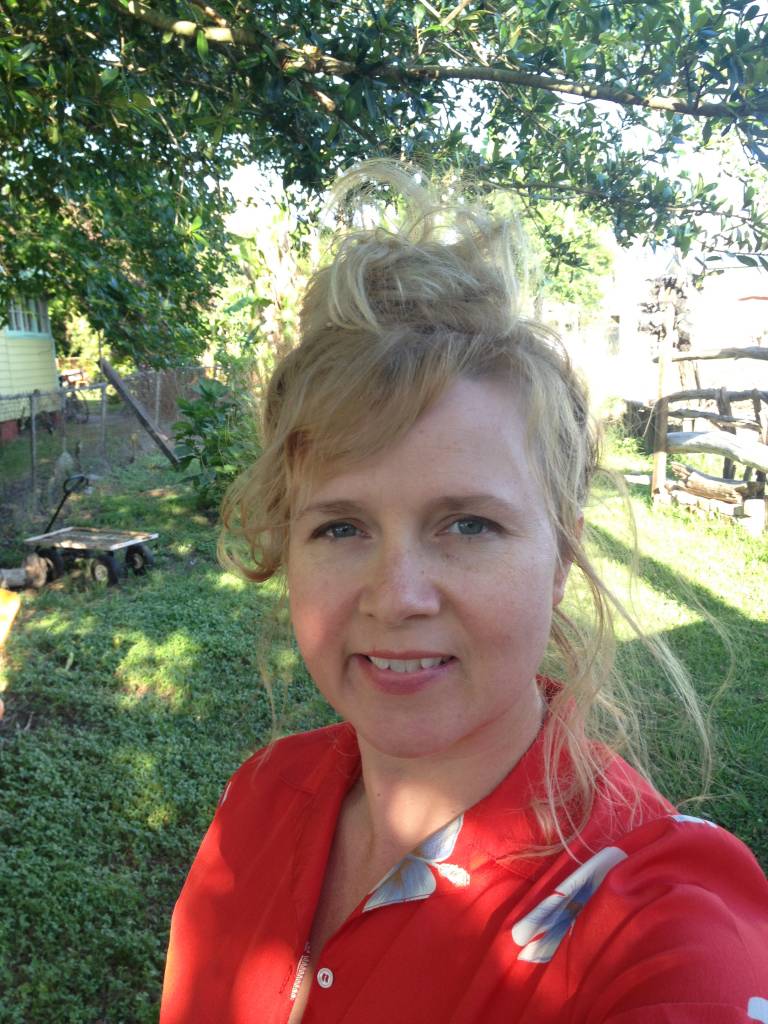The artworks in State of the Art range in size from paintings 3.5 inches square to installations that fill rooms (or the lower pond!). One of the large works in the exhibition is a humungous 13-foot by 23-foot fiber work by New Orleans-based artist Gina Phillips.
Viewed from across the gallery, the work depicts a composite scene made up of memories from the artist’s life, growing up in rural Kentucky. The figures are clear: the artist’s grandmother holding a guitar at the right side, herself at center, a house and truck in the upper left. Up close, however, it’s a whole different work.
Phillips uses a wealth of fiber materials in her work—fabric, old clothes, trimming, artificial hair—all stitched to a muslin backing to create a richly textured image. While Gina was here installing the work, I talked with her a bit about her process.
LD: Why so large?
GP: I like to shift scale when I’m working. Sometimes I work very small, but it’s hard for me, when I look at a wall, not to see it as my whole canvas. The original composition for the piece was almost a quarter of the size that it is. I did the drawing, the underpainting, and put it on the wall in my studio—and I kind of felt like I could keep going with it. So I went back to my original sketch and I was like, “okay, I definitely need to add some to the height.” It was fun. It’s just fun to have that kind of impact: to walk into the space and see an image that’s that big. At first, a lot of people think it’s just a painting. Then they get close to it and they realize it’s made out of all these bits of fabric and thread. That’s one thing I really like about working in this medium, I feel like It holds your interest on a very close level, right up close to the surface, and then really far back.
LD: What’s your process for creating a work like this?
GP: I always start out with a plain white muslin background so I can do my underpainting on that. From there I’m appliqueing—whatever, anything goes—on the surface. I had to do it in three parts to fit it on my machine. I would do one panel and put it on my studio wall so I could look over and reference it, because by the time I would get to the bottom of the panel, I didn’t exactly remember what I had at the top. And of course I had a picture of the overall underpainting to use as my map so I would know where I was in the piece, because the shapes are so large I could easily get confused.
LD: How did you come to this style of working? GP: Really backwards, I think probably a lot of artists do that. It comes out of a love of working with materials. I don’t know how to sew properly. The first piece I experimented with was all hand sewn. I was just experimenting with this new way of thinking about making art out of fabric. I don’t think I even knew how to use a sewing machine, really. I think it’s cool when an artist arrives at a process or a medium in a really naïve way, because you don’t know the rules and you can figure out these totally new techniques that you wouldn’t have thought of before. When Katrina hit, I’d still been using these regular household machines and I’d been struggling with trying to make big work, squishing fabrics through these little machines. Because I lost all the equipment, it forced me to re-examine and see what was out there. Then I learned that there was such a thing as a long-arm quilting machine. I don’t use it the way it’s intended, I use it as a kind of drawing-with-thread machine. It’s allowed me to work a lot faster, a lot bigger, and a lot easier.
LD: How long did it take to create this work? GP: That piece took me about three months. (LD: At this point I think I gasped audibly. Did I mention the work is thirty-four feet long???) It’s pretty crazy. When I tell people that, they think I’m going to say three years.I had a deadline and I just stayed focused. And I do like to work fast—for me that was a really long time to work on one piece.







